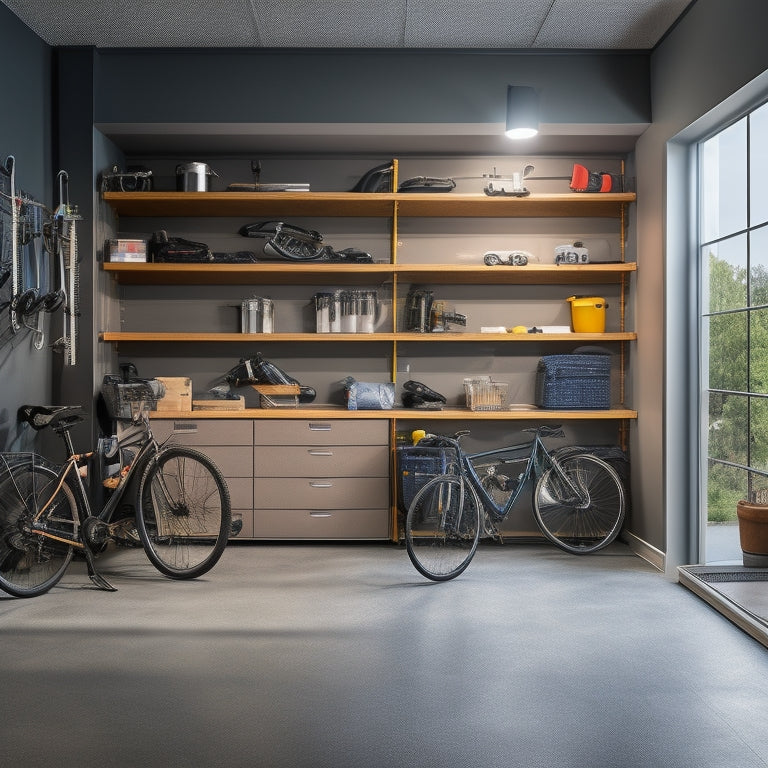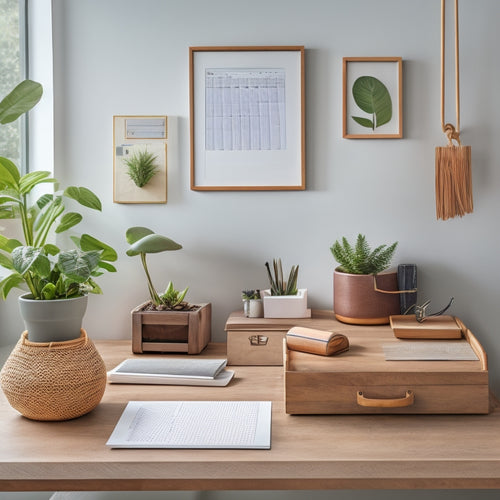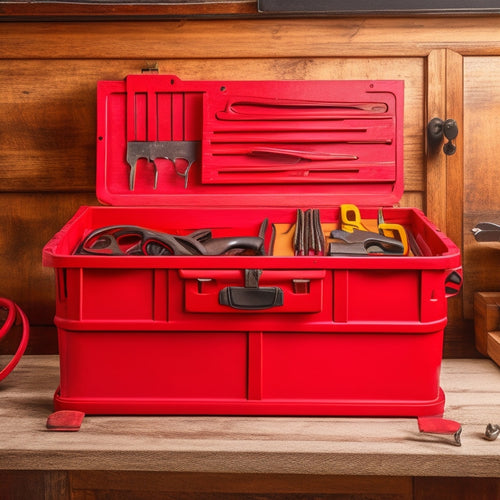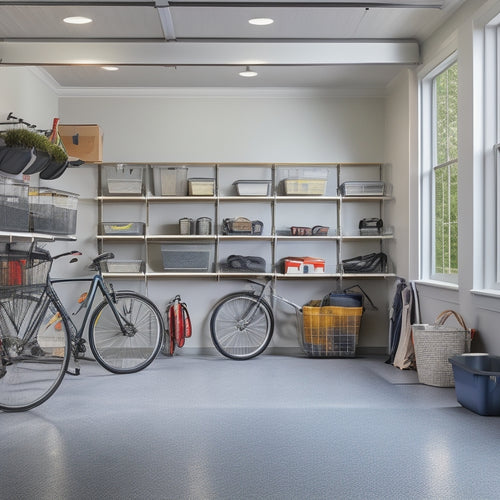
How to Create a Clutter-Free Garage With Organization Cabinets
Share
You can create a clutter-free garage with organization cabinets by following a structured approach that starts with evaluating your garage's unique dimensions, obstacles, and usage patterns to guarantee a customized solution that maximizes storage capacity and efficiency. Identify what you need to store, and categorize items into groups like tools, sports equipment, and seasonal decorations. Choose the right cabinets that fit your space and needs, considering materials, size, and style options. Measure carefully to assure a perfect fit, and select durable materials that can withstand garage wear and tear. Next, design a functional layout that incorporates vertical storage and additional features like lighting and accessories - and you'll be well on your way to a clutter-free garage that's both stylish and functional.
Key Takeaways
- Assess your garage space by measuring length, width, and height, and identify obstacles to determine the ideal cabinet layout and design.
- Choose the right cabinets by considering materials, size options, and styles that maximize storage while allowing easy movement and accessibility.
- Measure your garage precisely to ensure a perfect fit, taking into account obstructions, clearance, and door and drawer operation.
- Design a functional cabinet layout that evaluates item size, shape, and weight, and plans for specific storage needs and personal preferences.
- Maximize vertical storage by installing shelving solutions, pegboard systems, and overhead racks to increase storage capacity and reduce clutter.
Assessing Your Garage Space
As you stand in your garage, surrounded by clutter and chaos, take a deep breath and focus on the task at hand: evaluating your garage space. This vital step in creating a clutter-free garage is often overlooked, but it's important to understand the layout and functionality of your space before you start organizing.
Begin your garage assessment by measuring the length, width, and height of your garage. Take note of any obstacles, such as pipes, ductwork, or windows, that may impact your organization plans.
Next, categorize the items you've accumulated in your garage into groups, such as tools, sports equipment, and seasonal decorations. This will help you determine how much space you need to dedicate to each category.
Conduct a thorough space evaluation, considering the flow of traffic and how you want to use your garage. Identify areas that require the most attention, such as corners or walls that are prone to clutter.
Choosing the Right Cabinets
You'll want to select cabinets that fit your garage's unique dimensions, so consider cabinet size options that maximize storage while leaving enough clearance for easy movement.
When it comes to material and finish, think about durability, maintenance, and aesthetics - will you opt for rust-resistant metal, sturdy wood, or sleek composite materials?
Cabinet Size Options
When organizing your garage, frequently the greatest challenge lies in selecting the right cabinets to fit your specific storage needs.
Cabinet size options are essential to maximizing your garage's storage potential. You'll find standard sizes available, but custom options can be customized to fit unique spaces or items. Adjustable shelves within cabinets provide flexibility for storing items of varying heights.
Corner cabinets, tall cabinets, base cabinets, and wall cabinets offer a range of solutions for different areas of your garage. Modular systems allow you to mix and match cabinets to create a personalized storage system.
Compact designs are ideal for smaller garages or tight spaces. If you prefer a more open feel, consider open shelving instead of enclosed cabinets.
Consider the items you need to store and the space available to determine the best cabinet size and style for your garage. By choosing the right cabinets, you'll be able to create a clutter-free garage that's both functional and safe.
Material and Finish
With your garage cabinet size options in place, it's time to focus on the material and finish that will best suit your needs.
When it comes to choosing the right cabinets, you'll want to contemplate the type of wood, finish options, and color choices that fit your style and garage environment. You can opt for traditional wood types like oak, maple, or cherry, or investigate eco-friendly materials like bamboo or reclaimed wood.
Reflect on the finish options that will protect your cabinets from garage humidity and potential scratches. You can choose from a range of finishes, such as glossy, matte, or textured, depending on your texture preferences.
Additionally, think about the color scheme that will complement your garage's aesthetic.
Remember to prioritize maintenance tips when selecting your cabinets. Look for materials and finishes that are easy to clean and resistant to scratches and dents.
With careful contemplation, you'll find the perfect material and finish for your garage cabinets, ensuring a safe and organized space that meets your needs.
Measuring for Perfect Fit
Your garage's unique dimensions hold the key to a clutter-free space. To guarantee a seamless installation of your organization cabinets, you'll need to take precise measurements. Start by recording the length, width, and height of your garage. Identify any obstructions, such as windows, doors, or plumbing fixtures, that may impact cabinet placement.
Next, use measurement techniques to map out the space. Divide the area into zones, designating specific areas for storage, workstations, and walking paths. Consider the "work triangle" concept, where frequently used items are placed within easy reach. This space planning strategy will help you create an efficient and functional layout.
Take note of the dimensions of the cabinets you plan to install, including their width, height, and depth. Compare these measurements to your garage's dimensions, guaranteeing a comfortable fit.
Don't forget to leave clearance for doors and drawers to open fully. By carefully measuring your space, you'll be able to create a customized organization system that maximizes storage and minimizes clutter.
Selecting the Ideal Materials
You'll want to choose materials that can withstand the wear and tear of garage use, so consider the durability of each option.
Since budget is also a concern, you'll need to compare material costs to guarantee you're getting the best value.
Durability of Materials
Several factors contribute to a clutter-free garage, but none are as vital as selecting the ideal materials for your organization system. When choosing materials, you must take into account the durability of the components that will make up your garage organization cabinets.
You'll want to look for materials that offer weather resistance, ensuring your system can withstand the humid and moist environment of your garage. Additionally, take into account the weight capacity of the materials, as you'll need to store heavy items like tools and equipment. Aesthetic appeal is also essential, as you'll want your garage to look organized and visually pleasing.
Beyond these factors, think about the maintenance requirements of the materials. Will they require frequent cleaning or replacement?
You'll also want to take into account the installation ease, as well as the customization options available. Eco-friendly materials are a great choice, not only for the environment but also for your health and well-being.
Material Cost Comparison
How much are you willing to invest in your garage organization system? When it comes to selecting the ideal materials for your garage cabinets, budget considerations play a significant role.
You need to weigh the costs against the benefits of each material to guarantee you make a long-term investment that meets your needs.
Metal cabinets are a popular choice due to their durability and affordability. They can cost between $100 to $500, depending on the size and features.
However, they may not provide the same level of aesthetics as other materials.
Wooden cabinets offer a classic look and can be customized to fit your style. They range from $500 to $2,000, depending on the type of wood and design.
While they may be more expensive, they provide a natural, warm feel to your garage.
Plastic cabinets are another option, offering a budget-friendly solution at $50 to $200.
However, they may not be as durable as other materials.
Ultimately, consider your budget and the benefits each material provides. A well-planned investment in your garage organization system will pay off in the long run, providing a safe and functional space for years to come.
Designing Your Cabinet Layout
Three key factors will influence your cabinet layout design: the type of items you plan to store, the space available, and your personal preferences.
You'll need to evaluate the size, shape, and weight of the items you want to store, as well as any specific storage requirements, such as shelves for bins or hooks for bikes.
Next, assess the space available in your garage, keeping in mind any obstacles, like windows, doors, or pipes.
Finally, think about your personal preferences, including the style of cabinets you like, the level of customization you need, and the overall aesthetic you want to achieve.
When it comes to layout planning, you'll need to decide on the cabinet styles that best fit your needs.
Do you prefer wall-mounted cabinets for maximum floor space, or freestanding cabinets for flexibility?
Evaluate the traffic flow in your garage and plan your layout accordingly.
You may want to create zones for different activities, like a workspace or a storage area.
Maximizing Vertical Storage
By optimizing your garage's vertical space, you can greatly increase storage capacity while keeping the floor clear for parking, working, or other activities. This is especially important in a clutter-free garage, where floor space is essential.
To maximize vertical storage, consider installing shelving solutions, such as wall-mounted units that hold storage bins and seasonal items like winter clothing or summer sports equipment. Pegboard systems are also effective, allowing you to hang garden tools, bike storage, and other accessories within easy reach.
Overhead racks can store infrequently used items, like out-of-season decorations or luggage, freeing up space below. Toolbox organization systems can be mounted on walls or ceilings, keeping tools organized and out of the way.
Incorporating Additional Features
What would make your clutter-free garage organization system truly exceptional? By incorporating additional features, you can take your garage from functional to fantastic.
Consider adding shelf accessories like bins, baskets, or hooks to maximize storage capacity and keep items off the floor. This won't only keep your garage organized but also prevent tripping hazards.
Next, think about lighting options. Adequate lighting can greatly improve safety and visibility in your garage.
Install task lighting above workstations or under shelves to illuminate specific areas. You can also add ambient lighting to create a brighter, more welcoming atmosphere. This is especially important if you plan to spend a lot of time in your garage working on projects or hobbies.
Installing Cabinets and Shelves
You've optimized your garage's storage capacity with bins, baskets, and hooks, and enhanced its ambiance with thoughtful lighting options. Now, it's time to install cabinets and shelves to maximize your garage's organizational potential.
When choosing cabinet styles, evaluate the type of items you'll be storing. For heavy tools and equipment, sturdy steel cabinets are a good option. For lighter items like seasonal decorations, melamine or laminate cabinets may suffice. Don't forget to assess the color and finish to guarantee they blend seamlessly with your garage's aesthetic.
| Shelf Height | Recommended Use | Cabinet Style |
|---|---|---|
| 60-72 inches | Overhead storage for infrequently used items | Tall, narrow cabinets |
| 48-60 inches | Storage for bulky items like coolers or luggage | Wide, shallow cabinets |
| 36-48 inches | Easy access to frequently used items | Standard, medium-depth cabinets |
| 24-36 inches | Storage for small items like bins and baskets | Short, narrow cabinets |
| 12-24 inches | Display shelves for decorative items | Open shelving units |
Remember to install shelves at heights that allow for comfortable access and minimize straining. Always follow the manufacturer's instructions and take necessary safety precautions when installing cabinets and shelves to guarantee a safe and organized garage space.
Maintaining Your New Space
Throughout the process of organizing your garage, it's crucial to remember that maintaining your new space is essential to its long-term functionality and aesthetic appeal.
You've invested time and effort into creating a clutter-free garage, and now it's important to keep it that way.
To maintain your garage's organization, you'll need to establish a routine that includes regular cleaning and seasonal maintenance.
Here's what you should do:
- Set aside time each week to tidy up your garage, putting away items that are out of place.
- Schedule a deeper clean every month to tackle dirt, dust, and grime that can build up.
- Check your cabinets and shelves regularly to make sure they're still organized and functional.
- Perform seasonal maintenance tasks, such as cleaning out your gutters or inspecting your garage door.
- Consider implementing a "one in, one out" policy to prevent clutter from building up again.
Frequently Asked Questions
Can I Install Cabinets Myself or Should I Hire a Professional?
You're wondering if you should DIY the cabinet installation or hire a pro. While DIY installation can save you money, it requires skill and time; if you're short on either, consider hiring a professional for a safe and stress-free experience.
How Do I Keep My Garage Cabinets From Getting Dusty?
As you conquer the dusty Wild West of your garage, remember to regularly wipe down cabinets with a damp cloth, install door sweeps, and use dust-trapping mats to keep your organizational haven from becoming a dusty desert.
Are Custom Cabinets More Expensive Than Pre-Made Ones?
When you're deciding between custom and pre-made cabinets, you'll find that custom ones usually cost more, but they offer personalized benefits like precise fits and unique features that enhance safety and functionality, making the extra cost worthwhile.
Can I Use Garage Cabinets for Storing Hazardous Materials?
Like a ticking time bomb, hazardous materials can wreak havoc if not stored properly. You'll want to exercise extreme caution when selecting storage solutions, ensuring they're specifically designed for hazardous materials and meet safety standards, rather than using garage cabinets as a one-size-fits-all answer.
Will My Insurance Cover Damaged or Stolen Items in My Garage?
You'll want to review your garage insurance policy to understand what's covered in case of damage or theft, as coverage limits vary; check if hazardous materials, precious items, or specific storage conditions affect your policy's protection.
Conclusion
As you step into your newly organized garage, the calmness is palpable. Gone are the days of clutter and chaos, replaced by sleek cabinets and a sense of control. The air is fresh, the floor is clear, and your prized possessions shine like new. It's a far cry from the cramped, overwhelming space that once threatened to swallow you whole. You've tamed the beast, and in its place, you've created a haven of efficiency and tranquility.
Related Posts
-

Best Organizing Tools for a Clutter-Free Space
You're on a mission to change your cluttered space into a peaceful oasis, and you're looking for the best organizing ...
-

Portable Tool Chest Essentials
When stocking your portable tool chest, you'll want to prioritize essential hand tools like hammers, tape measures, a...
-

Bin Garage Storage Ideas for Maximizing Space
You can greatly maximize your garage's storage space by utilizing vertical space with ceiling storage bins, stacking ...


